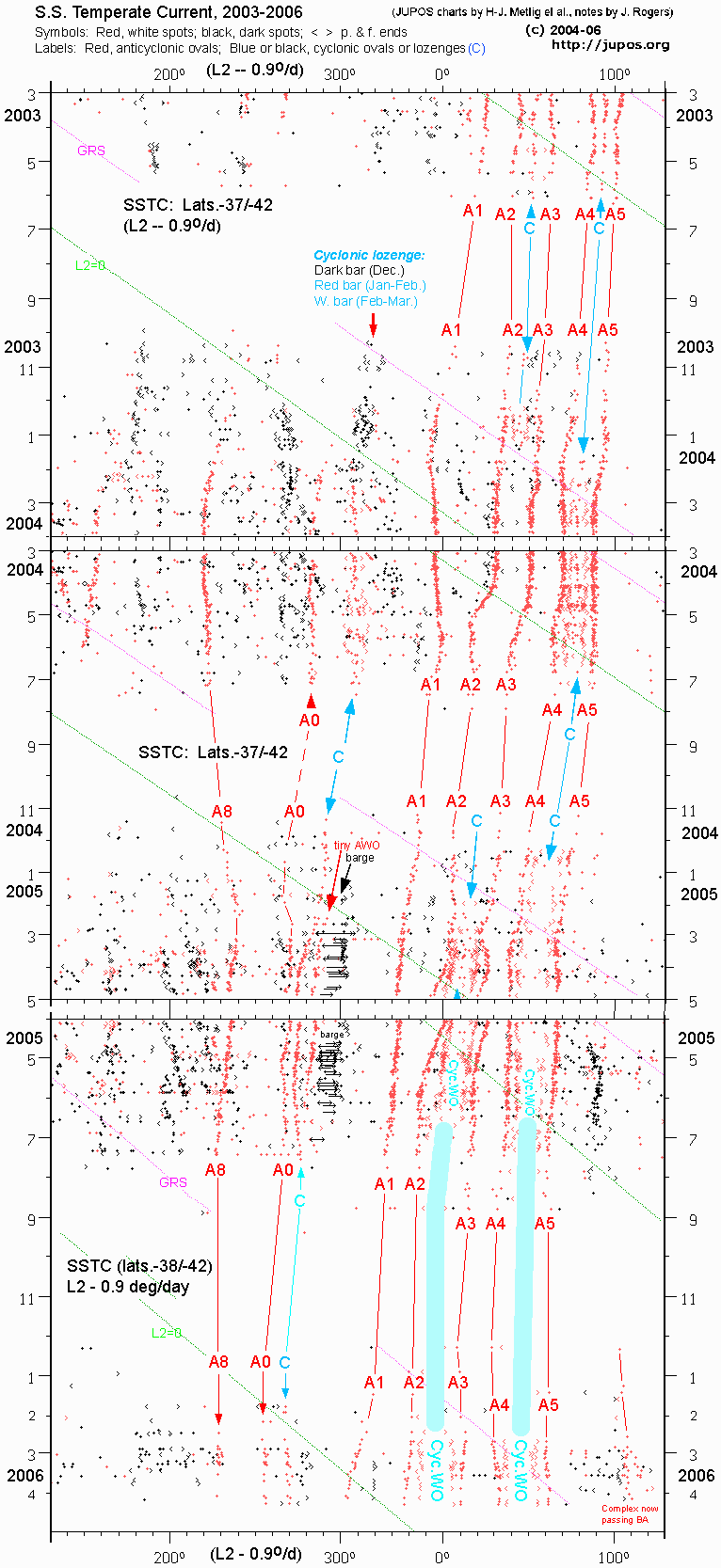
[4]
Long-lived circulations in the S.S. Temperate domain
(report, 2006 April 13).
This bulletin reviews the history of the circulations in the S.S. Temperate domain over the last few years. Attached is a composite of JUPOS charts (prepared by Hans-Joerg Mettig and colleagues), and three montages of high-resolution images from 2004, 2005, and 2006, showing these long-lived spots


The
first group of interest comprises the set of five anticyclonic white ovals (AWOs),
named A1 to A5. Initially there
were seven, but A6 and A7 merged in 2002 March, and the product probably merged
with A5 in turn during the following solar conjunction, so there have been five
AWOs since 2003.
A
question of theoretical interest is whether they are separated by cyclonic
circulations. These can be of several types: white ovals (WO), dark streaks or
barges, red-brown barges, and 'folded filamentary regions' (FFRs).
FFRs are turbulent chaotic circulations with thunderstorms, according to
spacecraft imagery, but are difficult to detect from Earth because at low
resolution they have low contrast. So
where ground-based images suggest subtle grey streaks or spots, there may be a
FFR.
The
most conspicuous cyclonic circulations in this cluster are long white ovals
between A2-A3 and between A4-A5. There
were already cyclonic white ovals in these locations in 2002/03 [see images of
the GRS in 2003 Jan., not included here], though the one between A4-A5 was
invisible in late 2003; and the one between A2-A3 broke up in 2004 Jan.
Then the WO re-formed between A4-A5 in 2004 Feb. From then until 2005
April it grew progressively longer, from ~10 deg. to ~20 deg. long; this is
typical of elongated cyclonic circulations (such as historic STB Fades: Rogers,
1995). In 2005-2006 its length has
fluctuated slightly. Meanwhile the
WO between A2-A3 reappeared in early 2005 and likewise grew progressively
longer, from ~11 deg. then to ~20 deg. now.
The
second interesting cluster of spots precedes the AWOs, and includes at least one
strikingly variable cyclonic circulation. This
was a very dark brown streak or 'barge' from 2003 Nov. to 2004 Jan.
Then it turned vivid red (2004 Feb.10) and disappeared (late Feb.) –
reappearing as a bright white oval in June.
This behaviour strongly resembled that of a similar cyclonic circulation
in the STB from 1994 to 1998, which we called the 'Morphing Spot' [see BAA
reports; the report for 1994, by Mike Foulkes and J.R., is still unpublished].
The STB Morphing Spot was preceding AWO FA.
The SSTB morphing spot in 2004 was f. a newly forming AWO, which we here
call A0.
In
2004/05, A0 and the resulting cyclonic WO still existed, and another spot pair
formed immediately f. them: a small AWO, and a dark streak ('barge') which
turned red-brown as it passed oval BA in 2005 Jan. These are no longer present in 2006.
Further
v-hi-res images will be of interest. One
aim is to see whether there are FFRs between other pairs of AWOs.
Recent v-hi-res images do seem to show FFRs
p. AWOs A0, A1, and A4, although these identifications are inevitably
tentative. It has never before been
possible to resolve these circulations adequately from Earth. Another aim is to
document the transformations between different forms more consistently than
before. Apart from the changes we have seen in 'morphing spots', we also know
from Voyager movies that SSTB-WOs can turn into FFRs suddenly, so amateur
imagers now have the opportunity to follow such events.
Finally, we need to determine the complete life cycle of the AWOs, which
used to be difficult for amateurs to detect at all, but are now striking
landmarks on many of your images.
(Add. note: As the old AWOs merged leaving only 5 by 2003, new AWOs (A8
and A0) have appeared from 2004 onwards. Thus the number of S.S.Temp. AWOs has
remained constant at 6-7 since 1986, in spite of several appearances and
disappearances and mergers.)
John
Rogers,
2006
April 13.